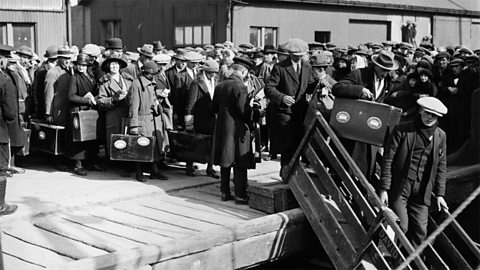Land issues in the Highlands and Islands
The land raids
The Crofters Act of 1886 ended the Highland ClearancesThe forced eviction of inhabitants of the Highlands and Western Island during the 18th and 19th Centuries. The land was cleared by landlords and mostly used for sheep grazing as a profitable means of income. The native population evicted were moved to the coast, central Scotland or abroad as emigrants. and meant that crofters could not be suddenly evicted from land they rented from the landowner. However, poverty and shortage of good quality land meant that protest and discontent continued in the Highlands.
When the war ended, many soldiers from the Highlands and Islands returned home with the firm belief that they had been promised land as a reward for fighting for their country. When this land was not given to them fast enough, many began land raids.
Land raids involved men occupying land they believed they had a right to work on, without the current landownerâs permission. Returning soldiers simply âsquattedâ on land throughout the Highlands. Some cited an old law which they claimed gave them the right to the land if they could build a wooden shelter and a hearth on which they could make a fire.
Government response
In response, the government passed the Land Settlement Act of 1919. It stated that land would be made available for men who had served in the war. This left the problem of how to obtain enough land to provide. For the Act to be successful, land would have to be purchased from the current owners but the government could not afford to do this.
Land raids continued and the government was in a difficult position. It was too expensive to meet the demands of the ex-servicemen and to punish the land raiders would be very unpopular. However, to do nothing about land raiders would undermine the authority of the government.
By the end of the 1920s the problem of land ownership, overcrowding and poverty had still not been resolved in the Highlands, and many people saw emigration as the only option.
Post-war emigration

In the period between the two World Wars, Scotland had the highest emigration rate of any European country. Many Scots saw emigration as an escape from unemployment and poverty in the Highlands and also from the depressed industrial areas of central Scotland.
The Empire Settlement Act of 1922 provided the first large scale government assisted migration programme. It was intended to boost the rural populations of Canada and other parts of the British Empire. Subsidies were paid to emigrants who agreed to work the land for a certain period of time.
The Canadian government actively encouraged emigration from Scotland by promoting their country. Full-time agents encouraged emigration to Canada from offices in Glasgow and Inverness.
The 1931 census showed a drop in Scotland's population for the first time since official records began in 1801.